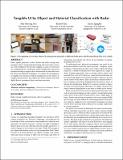Files in this item
Tangible UI by object and material classification with radar
Item metadata
| dc.contributor.author | Yeo, Hui Shyong | |
| dc.contributor.author | Ens, Barrett | |
| dc.contributor.author | Quigley, Aaron John | |
| dc.date.accessioned | 2018-03-16T16:30:06Z | |
| dc.date.available | 2018-03-16T16:30:06Z | |
| dc.date.issued | 2017-11-27 | |
| dc.identifier | 252305883 | |
| dc.identifier | 6ade5f6f-ea1b-4568-b12b-7911d7afedfe | |
| dc.identifier | 85040186652 | |
| dc.identifier | 000440716400014 | |
| dc.identifier.citation | Yeo , H S , Ens , B & Quigley , A J 2017 , Tangible UI by object and material classification with radar . in SA '17 SIGGRAPH Asia 2017 Emerging Technologies . , 14 , ACM , New York , 10th ACM SIGGRAPH Conference and Exhibition on Computer Graphics and Interactive Techniques in Asia , Bangkok , Thailand , 27/11/17 . https://doi.org/10.1145/3132818.3132824 | en |
| dc.identifier.citation | conference | en |
| dc.identifier.isbn | 9781450354042 | |
| dc.identifier.other | ORCID: /0000-0002-5274-6889/work/41757149 | |
| dc.identifier.uri | https://hdl.handle.net/10023/12965 | |
| dc.description.abstract | Radar signals penetrate, scatter, absorb and reflect energy into proximate objects and ground penetrating and aerial radar systems are well established. We describe a highly accurate system based on a combination of a monostatic radar (Google Soli), supervised machine learning to support object and material classification based Uls. Based on RadarCat techniques, we explore the development of tangible user interfaces without modification of the objects or complex infrastructures. This affords new forms of interaction with digital devices, proximate objects and micro-gestures. | |
| dc.format.extent | 2 | |
| dc.format.extent | 15650304 | |
| dc.language.iso | eng | |
| dc.publisher | ACM | |
| dc.relation.ispartof | SA '17 SIGGRAPH Asia 2017 Emerging Technologies | en |
| dc.subject | Radar sensing | en |
| dc.subject | Tangible interaction | en |
| dc.subject | Object recognition | en |
| dc.subject | QA75 Electronic computers. Computer science | en |
| dc.subject | T Technology | en |
| dc.subject | NS | en |
| dc.subject.lcc | QA75 | en |
| dc.subject.lcc | T | en |
| dc.title | Tangible UI by object and material classification with radar | en |
| dc.type | Conference item | en |
| dc.contributor.institution | University of St Andrews. School of Computer Science | en |
| dc.identifier.doi | https://doi.org/10.1145/3132818.3132824 |
This item appears in the following Collection(s)
Items in the St Andrews Research Repository are protected by copyright, with all rights reserved, unless otherwise indicated.

